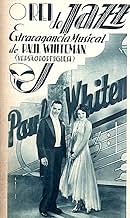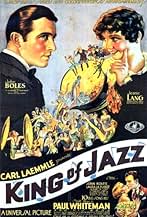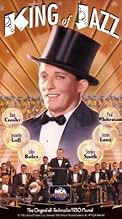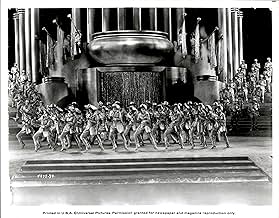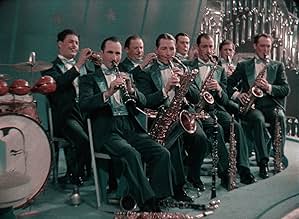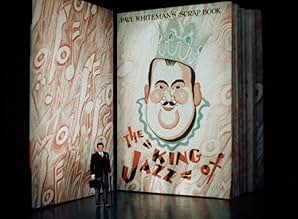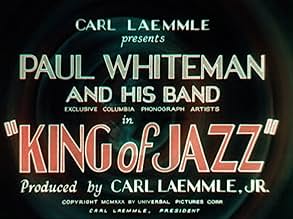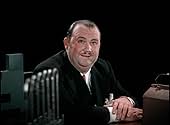AVALIAÇÃO DA IMDb
6,7/10
1,8 mil
SUA AVALIAÇÃO
Adicionar um enredo no seu idiomaA rotund bandleader leads a series of theatrical sketches, dance numbers, special effects, and animated segments.A rotund bandleader leads a series of theatrical sketches, dance numbers, special effects, and animated segments.A rotund bandleader leads a series of theatrical sketches, dance numbers, special effects, and animated segments.
- Direção
- Roteiristas
- Artistas
- Ganhou 1 Oscar
- 4 vitórias no total
Harry Barris
- One of the Rhythm Boys
- (as The Rhythm Boys)
Bing Crosby
- One of the Rhythm Boys
- (as The Rhythm Boys)
Al Rinker
- One of the Rhythm Boys
- (as The Rhythm Boys)
Carla Laemmle
- Chorine
- (as Beth Laemmle)
- Direção
- Roteiristas
- Elenco e equipe completos
- Produção, bilheteria e muito mais no IMDbPro
Avaliações em destaque
1930's King of Jazz is the strangest and most surreal of the early sound cycle of movie studio revues. Very few films shot completely in two-strip Technicolor survive - this is one of them. Warner Bros. probably made the most all-Technicolor films in the early sound era, but since most of them were Vitaphone the films have long since been lost in most cases.
The 1929 and 1930 early sound revues were made by the studios primarily to showcase their talent in an all-talking setting. MGM's "Hollywood Revue of 1929" started the cycle, and did a pretty good job. However, other studios lost sight of the goal and the revues that followed were often clumsily put together and didn't even showcase talent that belonged to the studio.
"The King of Jazz" is a surprise not only because it holds up so well with time, but because it is such a non-typical product for Universal Studios of that era. Universal of the 20's and 30's mainly made westerns for rural moviegoers with an occasional prestige picture and they were beginning to dabble in the horror genre for which the studio is most remembered. However, at this time they were also known for their thrift, which went out the window when they made this film. The film starts out with a cartoon showing how Paul Whiteman - who called himself The King of Jazz - discovered Jazz. What follows are a sequence of musical and comedy routines. This film doesn't make the mistake of trying to sew the numbers together with some maudlin backstage melodrama. It simply presents the numbers in sequence. Most of the talent here is not under long-term contract to Universal. Laura LaPlante is one of the rare exceptions to that rule. The musical numbers are a delight and it is great to see Bing Crosby at the very beginning of his career. The Brox Sisters light up this film just as they did MGM's revue with "Singin in the Rain". The whole thing is so lively and done with with such innovation and energy considering the static camera of the early talkie era that I can't believe Universal has never thought to put this on DVD. They made this one great musical and didn't really make another one until 1936's "Showboat".
My favorite number is "Song of the Dawn" featuring handsome John Boles with his piercing eyes in close up during most of the number belting out a song with that wonderful tenor voice of his. The most memorable number though has got to be "Happy Feet" with dancing shoes and the Sisters G as singing heads in a shoebox. This number also has the aptly named Al "Rubber Legs" Norman showing us the moon dance 28 years before Michael Jackson was even born.
Highly recommended for the fun of it all.
The 1929 and 1930 early sound revues were made by the studios primarily to showcase their talent in an all-talking setting. MGM's "Hollywood Revue of 1929" started the cycle, and did a pretty good job. However, other studios lost sight of the goal and the revues that followed were often clumsily put together and didn't even showcase talent that belonged to the studio.
"The King of Jazz" is a surprise not only because it holds up so well with time, but because it is such a non-typical product for Universal Studios of that era. Universal of the 20's and 30's mainly made westerns for rural moviegoers with an occasional prestige picture and they were beginning to dabble in the horror genre for which the studio is most remembered. However, at this time they were also known for their thrift, which went out the window when they made this film. The film starts out with a cartoon showing how Paul Whiteman - who called himself The King of Jazz - discovered Jazz. What follows are a sequence of musical and comedy routines. This film doesn't make the mistake of trying to sew the numbers together with some maudlin backstage melodrama. It simply presents the numbers in sequence. Most of the talent here is not under long-term contract to Universal. Laura LaPlante is one of the rare exceptions to that rule. The musical numbers are a delight and it is great to see Bing Crosby at the very beginning of his career. The Brox Sisters light up this film just as they did MGM's revue with "Singin in the Rain". The whole thing is so lively and done with with such innovation and energy considering the static camera of the early talkie era that I can't believe Universal has never thought to put this on DVD. They made this one great musical and didn't really make another one until 1936's "Showboat".
My favorite number is "Song of the Dawn" featuring handsome John Boles with his piercing eyes in close up during most of the number belting out a song with that wonderful tenor voice of his. The most memorable number though has got to be "Happy Feet" with dancing shoes and the Sisters G as singing heads in a shoebox. This number also has the aptly named Al "Rubber Legs" Norman showing us the moon dance 28 years before Michael Jackson was even born.
Highly recommended for the fun of it all.
Universal spent over a year making this movie -- Paul Whiteman's band set forth for Hollywood on a chartered train called the "Old Gold Special" in January 1929 (Old Gold Cigarettes sponsored his CBS radio program) and arrived, ready to work, only to find that no one at Universal had bothered to come up with a script. Seven months later he headed himself and his band back to New York after telling the "suits" at Universal he wasn't coming back until there was a finished script and the film was ready to shoot. During the stand-down Whiteman lost the best musician he ever had, Bix Beiderbecke, to Bix's chronic alcoholism, and Universal lost the originally assigned director, Paul Fejos, when he had a nervous breakdown while shooting another film. By the time Whiteman returned, the Great Depression had hit, the Zeitgeist had changed and the American people weren't in the mood for lavish musicals anymore. So "King of Jazz" became a legendary box-office flop.
It's a fate the movie didn't deserve: though there are a few scenes in which director John Murray Anderson falls back on the typical long-shots of chorus lines that make them look like ants on a wedding cake, for the most part his direction is vividly imaginative, fully the equal of what Busby Berkeley was doing on his first film, "Whoopee," another all-color musical being filmed at the same time. Anderson gives us numbers from overhead, from side angles, and uses the swooping camera movements of the so-called "'Broadway' Crane" (invented by cinematographer Hal Mohr and director Paul Fejos for Universal's 1929 film of the hit musical "Broadway") to deliver dazzling images and splendors to delight the eye and avoid the static quality of many of the early musicals. Anderson had come to Hollywood from his experience directing most of the Ziegfeld Follies on stage and running an acting school that trained Bette Davis and Lucille Ball, and for this film he was given virtually unprecedented authority. "King of Jazz" should have been his ticket to a major film career, but instead after its failure he retreated to the stage and only worked on two more films, the 1944 Esther Williams vehicle "Bathing Beauty" (for which he staged the incredible final number, often misattributed to Berkeley!) and Cecil B. DeMille's circus drama "The Greatest Show on Earth" (1953). It's a crime against culture that Anderson wasn't given the job of directing "The Great Ziegfeld" (1936), since he knew Ziegfeld's style (indeed, had helped create it) and he knew how to make a movie; an Anderson-directed "Great Ziegfeld" could have been a masterpiece instead of the ponderous bore (redeemed only by the acting of William Powell and Myrna Loy) MGM and hack director Robert Z. Leonard actually gave us.
"King of Jazz" was one of the handful of revues (a Broadway term for a musical with no plot) filmed in 1929 and 1930, including MGM's "Hollywood Revue of 1929," Warner Bros.' "The Show of Shows," Fox's "Fox Movietone Follies of 1929," and Paramount's "Paramount on Parade." (There was also a British version, "Elstree Calling," in which the framing scenes showing actor Gordon Harker tuning in variety performers on an early TV were directed by Alfred Hitchcock, who didn't think the assignment was important enough to put the film on his official résumé.) But "King of Jazz" is better than all of them, even though Universal's list of contract players was far less illustrious than those of their major-studio competitors (the biggest "names" in this movie who weren't part of Whiteman's organization were Laura LaPlante and John Boles). It helps that the comedy scenes between the big musical numbers are kept to a minimum, and are short, genuinely funny and surprisingly racy for a 1930 film. The only thing that badly dates this movie (and led me to rate it 9 instead of 10) are the unfunny and badly dated novelty songs, including "Oh, How I'd Love to Own a Fish Store," "Has Anybody Here Seen Nellie?" and Wilbur Hall's performance of "Stars and Stripes Forever" on a bicycle pump.
"King of Jazz" is a towering musical masterpiece, rivaled only by "Whoopee" at the top of the heap for pre-"42nd Street" musicals. (The Lubitsch and Mamoulian films for Maurice Chevalier and Jeanette MacDonald are in a separate category altogether.) The film is a tribute to the genius of its director, John Murray Anderson, though the one Academy Award it won was for its art director, Herman Rosse, probably the first individual ever to win an Oscar for an all-color film. "King of Jazz" is a music that will dazzle you with spectacular moment after spectacular moment, including the "Rhapsody in Blue" sequence that, along with the "New York Rhapsody" sequence in the 1931 film "Delicious," does more justice to George Gershwin's music than any sequence using it until the 1951 ballet in "An American in Paris."
It's a fate the movie didn't deserve: though there are a few scenes in which director John Murray Anderson falls back on the typical long-shots of chorus lines that make them look like ants on a wedding cake, for the most part his direction is vividly imaginative, fully the equal of what Busby Berkeley was doing on his first film, "Whoopee," another all-color musical being filmed at the same time. Anderson gives us numbers from overhead, from side angles, and uses the swooping camera movements of the so-called "'Broadway' Crane" (invented by cinematographer Hal Mohr and director Paul Fejos for Universal's 1929 film of the hit musical "Broadway") to deliver dazzling images and splendors to delight the eye and avoid the static quality of many of the early musicals. Anderson had come to Hollywood from his experience directing most of the Ziegfeld Follies on stage and running an acting school that trained Bette Davis and Lucille Ball, and for this film he was given virtually unprecedented authority. "King of Jazz" should have been his ticket to a major film career, but instead after its failure he retreated to the stage and only worked on two more films, the 1944 Esther Williams vehicle "Bathing Beauty" (for which he staged the incredible final number, often misattributed to Berkeley!) and Cecil B. DeMille's circus drama "The Greatest Show on Earth" (1953). It's a crime against culture that Anderson wasn't given the job of directing "The Great Ziegfeld" (1936), since he knew Ziegfeld's style (indeed, had helped create it) and he knew how to make a movie; an Anderson-directed "Great Ziegfeld" could have been a masterpiece instead of the ponderous bore (redeemed only by the acting of William Powell and Myrna Loy) MGM and hack director Robert Z. Leonard actually gave us.
"King of Jazz" was one of the handful of revues (a Broadway term for a musical with no plot) filmed in 1929 and 1930, including MGM's "Hollywood Revue of 1929," Warner Bros.' "The Show of Shows," Fox's "Fox Movietone Follies of 1929," and Paramount's "Paramount on Parade." (There was also a British version, "Elstree Calling," in which the framing scenes showing actor Gordon Harker tuning in variety performers on an early TV were directed by Alfred Hitchcock, who didn't think the assignment was important enough to put the film on his official résumé.) But "King of Jazz" is better than all of them, even though Universal's list of contract players was far less illustrious than those of their major-studio competitors (the biggest "names" in this movie who weren't part of Whiteman's organization were Laura LaPlante and John Boles). It helps that the comedy scenes between the big musical numbers are kept to a minimum, and are short, genuinely funny and surprisingly racy for a 1930 film. The only thing that badly dates this movie (and led me to rate it 9 instead of 10) are the unfunny and badly dated novelty songs, including "Oh, How I'd Love to Own a Fish Store," "Has Anybody Here Seen Nellie?" and Wilbur Hall's performance of "Stars and Stripes Forever" on a bicycle pump.
"King of Jazz" is a towering musical masterpiece, rivaled only by "Whoopee" at the top of the heap for pre-"42nd Street" musicals. (The Lubitsch and Mamoulian films for Maurice Chevalier and Jeanette MacDonald are in a separate category altogether.) The film is a tribute to the genius of its director, John Murray Anderson, though the one Academy Award it won was for its art director, Herman Rosse, probably the first individual ever to win an Oscar for an all-color film. "King of Jazz" is a music that will dazzle you with spectacular moment after spectacular moment, including the "Rhapsody in Blue" sequence that, along with the "New York Rhapsody" sequence in the 1931 film "Delicious," does more justice to George Gershwin's music than any sequence using it until the 1951 ballet in "An American in Paris."
When I first saw this film, I was amazed at some parts and extremely disappointed at others. To be sure, the comedy acts are absolutely abysmal. (Audiences in 1930 didn't find them any funnier than audiences today, so don't feel too bad about hating them.) Also, a lot of the vocalists are grating and painful to listen to. Of course, the parts where the film really shines are the parts that feature the magnificent Paul Whiteman orchestra. This band has been unfairly maligned because although Paul Whiteman was titled "The King of Jazz", his orchestra was not a jazz band per se. But man, were they ever good musicians! Just get a load of the "Meet the Boys" segment towards the beginning...Harry Goldfield doing his best Henry Busse impersonation, Joe Venuti and Eddie Lang playing "Wildcat" in one of their few film appearances, the entire violin section playing a lovely rendition of Caprice Viennois, Chester Hazlett and Roy Bargy doing a pretty rendition of Nola, followed by Wilbur Hall's trombone virtuosity display on the same number. (And let's not forget little Mike Pingitore on "Linger Awhile"!)
Oh yes, and did I mention it has Bing Crosby's first appearance in a feature film? He's with the Rhythm Boys, and man, those guys are HOT! Just get a load of them on "Happy Feet". And check out eccentric dancer Al Norman if you want to see something really crazy.
Last but not least, I would like to mention Wilbur Hall's wonderful trick violin act, and, might I add, the most unique rendition of a Sousa march you'll ever hear in your lifetime. (You haven't heard "The Stars and Stripes Forever" until you've heard it on a bicycle pump!)
Go get yourself a copy and have fun!
Oh yes, and did I mention it has Bing Crosby's first appearance in a feature film? He's with the Rhythm Boys, and man, those guys are HOT! Just get a load of them on "Happy Feet". And check out eccentric dancer Al Norman if you want to see something really crazy.
Last but not least, I would like to mention Wilbur Hall's wonderful trick violin act, and, might I add, the most unique rendition of a Sousa march you'll ever hear in your lifetime. (You haven't heard "The Stars and Stripes Forever" until you've heard it on a bicycle pump!)
Go get yourself a copy and have fun!
This has an animation and in-camera tricks introduction. The main body is a big musical presenting band leader Paul Whiteman as The King of Jazz. It's an early musical a few years after the introduction of sound. It's a series of musical numbers on a big stage setting. It's a large production but there is no overarching connecting plot. The main connecting device is a giant book that is flipped to get to the next chapter. It's also in Technicolor. There are comedic interstitial scenes. As a historical document, it is absolutely fascinating. It's almost Vaudeville on film in that it's just a lot of performers performing on stage. It is a movie of a bygone era. It's also the first film with Bing Crosby. It was a bit of a failure at the time which may be due to a flood of similar musicals. It's a scattershot of lavish musical scenes without much connective tissue. By the midway point, any novelty is worn out as it all becomes more and more of the same fascinating nothingness. It has no story and it's not concentrating on any single character other than Paul Whiteman who is mostly simply a face. This may not be a great film but it is a fascinating one.
Paul Whiteman was a huge star in the 20s with his terrific jazz band. He might have been the original star band leader. In "The King of Jazz" he also shows himself to be a decent comic actor as well. He's best remembered for his recording of Gershwin's "Rhapsody in Blue," which is featured in this early revue film.
"King of Jazz" is solid entertainment with some lavish and grand-scale production numbers that boast Bing Crosby, John Boles, Laura LaPlante, the Brox Sisters, Jeanie Lang, and of course Whiteman's band.
Best songs are "Happy Feet," "A Bench in the Park," "The Song of the Dawn," and a jazzy "Bluebirds and Blackbirds" number with Crosby as one of the Rhythm Boys (with Harry Barris and Al Rinker).
Al Norman does an amazing dance number to "Happy Feet." Jeanette Loff is rather bland in the "bridal veil" number. The Sisters G in their Louise Brooks hairdos are OK in their dance numbers. And there's a lot of short comedy bits that feature Walter Brennan, Slim Summerville, Grace Hayes, Merna Kennedy, William Kent, and others.
Although I still prefer "The Hollywood Revue of 1929" this revue is also excellent in its use of lavish production numbers, color, and special effects. For fans of early musicals this one is not to be missed.
Whiteman, Crosby, and Boles are all great.
"King of Jazz" is solid entertainment with some lavish and grand-scale production numbers that boast Bing Crosby, John Boles, Laura LaPlante, the Brox Sisters, Jeanie Lang, and of course Whiteman's band.
Best songs are "Happy Feet," "A Bench in the Park," "The Song of the Dawn," and a jazzy "Bluebirds and Blackbirds" number with Crosby as one of the Rhythm Boys (with Harry Barris and Al Rinker).
Al Norman does an amazing dance number to "Happy Feet." Jeanette Loff is rather bland in the "bridal veil" number. The Sisters G in their Louise Brooks hairdos are OK in their dance numbers. And there's a lot of short comedy bits that feature Walter Brennan, Slim Summerville, Grace Hayes, Merna Kennedy, William Kent, and others.
Although I still prefer "The Hollywood Revue of 1929" this revue is also excellent in its use of lavish production numbers, color, and special effects. For fans of early musicals this one is not to be missed.
Whiteman, Crosby, and Boles are all great.
Você sabia?
- CuriosidadesThe animation sequence, created by Walter Lantz, was the first Technicolor animation ever produced.
- Erros de gravaçãoIn the introduction to ''Ladies of the Press" Grace Hayes is listed as 'Third Reporter' and Kathryn Crawford is listed as 'Fourth Reporter'. This is the reverse of the actual case. Grace Hayes is easily recognizable as the 'Rough Wife' in "Do Things for You". She is the fourth and final reporter in the skit.
- Citações
Announcer: You don't mean to tell me that you are well-versed in the intricacies of the art of Terpsichore?
Paul Whiteman: No, but I can dance.
- Versões alternativasRestored in 2016 with a running time of 99 minutes. This version replicates the scene continuity of the 1930 release version, including about a minute of exit music. A small amount of footage was not found and is covered by still photographs. This is the version that played at the Museum of Modern Art and Film Forum in 2016, and was released by the Criterion Collection on Blu-ray and DVD in 2018.
- ConexõesFeatured in The All Talking, All Singing, All Dancing Show (1973)
- Trilhas sonorasRhapsody in Blue
(uncredited)
Music by George Gershwin
Played briefly during the opening credits
Played by Paul Whiteman and Orchestra (as "The Paul Whiteman Orchestra") during the production number
Performed by Roy Bargy (piano)
Danced by Jacques Cartier with clarinet, along with the Russell Markert Girls and The Sisters G
Principais escolhas
Faça login para avaliar e ver a lista de recomendações personalizadas
- How long is King of Jazz?Fornecido pela Alexa
Detalhes
- Data de lançamento
- País de origem
- Idiomas
- Também conhecido como
- O Rei do Jazz
- Locações de filme
- Empresa de produção
- Consulte mais créditos da empresa na IMDbPro
Bilheteria
- Orçamento
- US$ 2.000.000 (estimativa)
- Tempo de duração
- 1 h 39 min(99 min)
Contribua para esta página
Sugerir uma alteração ou adicionar conteúdo ausente

